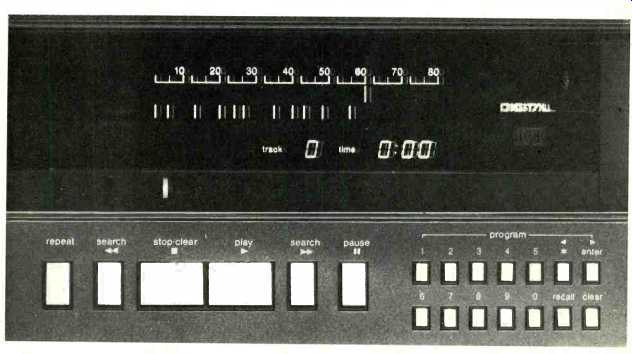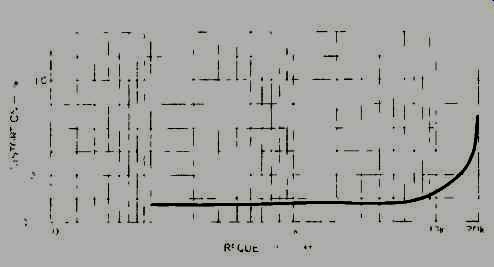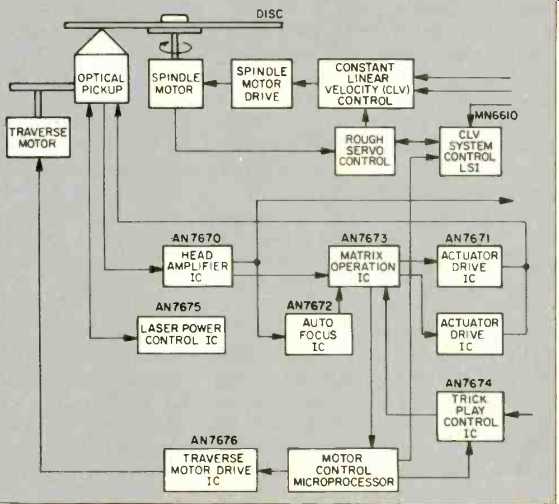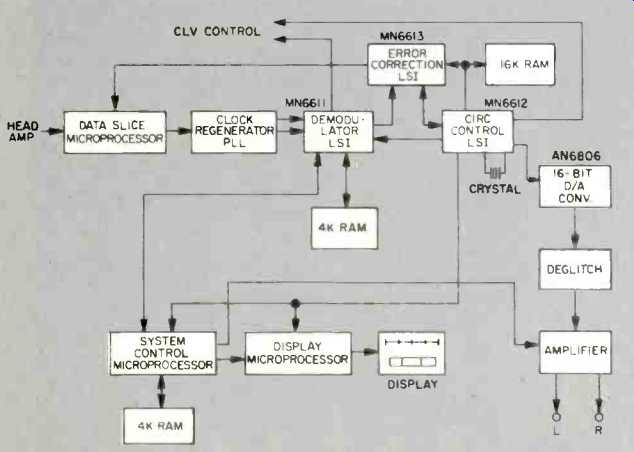
Manufacturer's Specifications:
Frequency Response: 4 Hz to 20 kHz, ±0.5 dB.
Dynamic Range: More than 90 dB.
S/N Ratio: More than 90 dB.
Channel Separation: More than 90 dB.
Harmonic Distortion: Less than 0.004% at 1 kHz, 0 dB.
Wow and Flutter: Unmeasurable.
Line Output Level: 1.5 volts, maximum (variable).
Output Impedance: 22 ohms.
Required Load Impedance: Greater than 5 kilohms.
Power Consumption: 48 watts.
Dimensions: 17 in. (43 cm) W x 5 1/4 in. (133 cm) H x 12 1/2 in. (315 cm) D.
Weight: 22 lbs. (10 kg).
Price: Not determined.
Company Address: One Panasonic Way. Secaucus, N.J. 07094.

Now that the compact digital disc player is a commercial reality in Japan (you can buy players and a growing assortment of discs at almost any audio shop in Tokyo), it is only reasonable to expect that we, too, will soon be able to add this component to our audio systems. It's no surprise, therefore, that just about every major manufacturer of audio equipment has come up with his own version of a CD player. Having already discovered that not all CD players are alike (and that they don't perform identically), I am now embarked upon a long-term project of evaluating and testing these incredible machines, one by one, as they become available. This month, it's the Technics SL-P10, which is configured in what can best be described as a cross between the earlier reviewed Sony CDP-101 and Hitachi DA-1000 players.
At first glance, the SL-P10 looks a bit like a front-loading cassette deck. When the power switch at the lower left of the front panel is turned on and the open/close key above it is depressed, a hinged disc-holder swings open, much like the familiar cassette-compartment doors on modern tape decks. Drop a compact digital disc in the slot, and the entire door closes smoothly and silently. Without further action by the operator, the disc begins to spin while the laser pickup quickly scans the disc's surface. A tiny red indicator light moves across a calibrated scale visible through the disc-compartment door, showing the laser pickup’s position relative to the radius of the disc. In less time than it takes to describe, the major display area to the right of the disc compartment displays total playing time of the record, the number of separate musical selections contained on the disc, and the approximate playing time of each selection.
This information is conveyed in the form of small vertical marker lines, set against a fluorescent time-display calibrated from 0 to 80 minutes, in 5-minute increments. The lower right portion of the display shows the track number being played as well as the time elapsed for that track.
Six light-touch buttons below the display area control the motion of the laser pickup head. These keys are for repeat, backward search, stop/clear, play, forward search, and pause. The forward and backward search keys advance the laser pickup in either direction at two rates of speed. Touch either key lightly, and the pickup moves in the desired direction fairly slowly. Touch the search key with more pressure, and the search speeds up, traversing a one-hour disc in approximately 10 seconds. Music is not heard during the search operation, but the highly informative displays described above keep you posted as to where you are. The repeat button causes a disc to be played from beginning to end, over and over again. Pressing the repeat button a second time releases this command. Pause, play and stop buttons operate much as they do in a cassette deck.
Of the 14 remaining small touch-buttons, 10 are numeric keys for programming selections in any desired order. Of the remaining four keys, one is marked with an asterisk and will cause the laser pickup to return to the start of the current selection or, if pushed twice, to the start of the selection immediately before it. A "Recall" key, when pressed and held, causes sequential display of all selected program numbers. An "Enter" key is used to memorize the desired selection numbers, while a "Clear" key erases programmed instructions. If the program feature is not used and the regular "Play" button is depressed, the unit will play the entire disc, from start to finish. The test disc I used contains 39 individual test bands, but that was not too many for the SL-P10's programming feature, which can handle as many as 63 steps of programmed playing! The rear panel of the player is equipped with a pair of line output jacks and an output level control.
Measurements

Fig. 1--Frequency response and channel separation.

Fig. 2--Distortion vs. frequency.
All tests for the Technics SL-P10 were conducted with the same special test disc (Sony YEDS 2) I used for measuring the performance of other CD players. Frequency response was flat within 0.1 dB from 100 Hz (the lowest test frequency provided on the test disc) to above 10 kHz. It was down by 0.2 dB at 16 kHz, 0.5 dB at 18 kHz, and 0.9 dB at 20 kHz. A plot of response and stereo channel separation is shown in Fig. 1. The slight roll-off exhibited at 20 kHz is certainly not worth criticizing and is probably due to the anti-aliasing filter tolerances in this particular sample.
Separation was excellent, too, though left-channel separation (as measured at the right-channel output) was some what better than right-channel separation. For example, at 1 kHz, I measured a separation of 85 dB "left to right" and 75.5 dB "right to left." Since there is no reason for this discrepancy within the digital domain, I suspect that the slight (and certainly negligible) decrease in separation on the "poorer" channel was a function of post-D/A conversion capacitance-leakage effects. This is further confirmed by the fact that separation also decreased at the top audio frequency tested (20 kHz). At that frequency, I still obtained separation figures of 69.5 and 69.0 dB from the left and right channels respectively.
================
DESIGN FEATURES
Technics has developed eight new ICs and four LSIs for digital signal processing in the SL-P10, one of which is an IC for servo control of laser pickup tracking. The player utilizes a semiconductor laser pickup which employs a three-beam tracking system. An expanded operational diagram of the laser optical system is shown in Fig. B1.
The optical deck (as Technics calls it) of the SL-P10 consists of the optical head, the spindle motor and a traverse stepping motor. All of these devices are servo-controlled, as shown in the block diagram of Fig. B2. The servo-control circuit of the optical head uses seven bipolar ICs developed for this product. The device identified as AN7675 controls laser power; AN7670 produces the r.f., tracking-error, and focus-error signals from the photo detector built into the optical head. The AN7673 takes care of signal processing, such as amplification and equalization, while ÁN7671 drives an actuator. The AN7672 handles auto-focus lock-in, and the AN7674 handles what Technics engineers call the "Trickplay" control of the actuator-a term not fully explained in the AES paper they delivered on the subject of this player a few months ago in California.
A block diagram of the player's signal-processing elements is reproduced as Fig. B3. The main functional elements of the signal-processing system are data slicing, clock regeneration, EFM (Eight to Fourteen Modulation) decoding. CIRC error correction, and D/A conversion. A new 16-bit chip for D/A conversion developed for the system (AN6806) is said to have extremely good linearity, thermal stability and high-speed response. Output nonlinearity claimed for the device is less than 0.003% at 0 dB, as shown in Fig. B4.
-L.F.

Fig. B1-Optical system used in Technics SL-P10 CD player.

Fig. B2-Block diagram of servo-control systems.

Fig. B3-Block diagram of signal-processing system.

Fig. B4 Linearity performance of D/A converter.
Input frequency is 1.05 kHz, and sampling frequency is 44.1 kHz.
================
Harmonic distortion versus frequency, at 0 dB (maximum) output level, is plotted in Fig. 2. It ranges from an extremely low 0.004% at mid-frequencies to 0.015% at 18 kHz. At 20 kHz, I noted some non-harmonically related beats appearing at the output of the player. These cause a "THD" reading of 0.24%, though in fact the reading was not truly harmonic distortion.
The test disc offers 1-kHz test tones at varying levels from 0 dB (maximum) all the way down to -90 dB. These are used to check linearity of the system. While I could not get down to the lowest of these test signals (it was already in the noise floor), I was impressed with the fact that linearity was perfect (not deviating by even as little as 0.1 dB) all the way down to -80 dB! Would that my loudspeakers were as linear! Signal-to-noise ratio, A-weighted, measured 96.5 dB.
Without the weighting network, S/N measured 86.1 dB below the maximum output-level reference of 0 dB. SMPTE IM measured 0.009% at 0 dB output level, increasing to 0.02% at a -10 dB level. The test disc contains a pair of twin tones at 19 and 20 kHz, and this band was used to measure so called CCIF-IM levels as well as the more complex IHF-IM levels. Results for CCIF IM (the 1-kHz beat produced be tween these closely spaced test tones) were 0.0021% at 0 dB and 0.003% at -10 dB. Values for IHF IM were not much greater and were therefore impossible to measure using my spectrum analyzer, whose range is limited to 80 dB. (Lowest possible reading would have been 0.01%.) De-emphasis tests included in the test disc enabled me to verify accuracy of the de-emphasis characteristic built into the SL-P10 player. The precise readings which should be obtained are -0.37, -4.53 and -9.04 dB at test frequencies of 1, 5 and 10 kHz respectively. I measured -0.35, -4.6 and -9.2 dB, which I would say is close enough!
Use and Listening Tests
Along with this player, I was loaned several new Compact Discs. Some of these were produced on behalf of Technics and were supplied as samplers of both popular (mostly recorded by Japanese musical groups) and classical mu sic. Musically, the less said about the pop samplers the better, though, of course, from a dynamic range and noise-free surface point of view they were magnificent. I just can't abide having good jazz classics such as "Take the A Train" corrupted by a Muzak-like rhumba (or was it samba?) beat! The classical sampler, by contrast, offered an excellent variety of musical fare, from the "Allegro (Spring)" of Vivaldi's Four Seasons to a Boston Pops medley from Fiddler on the Roof. Happily, most of the items on this disc were obviously transcribed from digital master tapes, so no tape noise intruded on the music.
After completing the bench tests on this player, my assistant and I had another product (analog) to measure. We decided to hook up the SL-P10 via our reference listening system and simply audition the remaining records while we continued working with the analog unit. Among other things, we listened to Mozart's entire Great Mass in C Minor on a Deutsche Grammophon release, with the Berlin Philharmonic conducted by Herbert von Karajan. Voices and orchestral sounds were so utterly clean and lifelike that every once in a while we just had to pause, look up, and confirm that this heavenly music was, indeed, pouring forth from a pair of loudspeaker systems. As many times as I've heard this noise-free, wide dynamic-range sound, it's still thrilling to hear new music reproduced this way.
There were also two Denon discs that I hadn't seen or heard before. One consisted of a medley of popular violin solo pieces by such diverse composers as Chausson, Sarasate, Saint-Saens, Ravel and Beethoven. The soloist was Jean-Jacques Kantorow, playing with the New Japan Philharmonic. The other disc was an old war-horse, Beethoven's Fifth, with Otmar Suitner conducting the Berlin Staatskapelle. It may be of interest to note that both of these discs carried retail prices of 3800 yen which, at current rates, works out to be about $14.00. Not bad for an hour's worth of the cleanest, most inspiring sound you have ever heard in your home. (I recently learned from a U.S.-based executive of Polygram Records that once the CD format is introduced here, his company intends to maintain a $14.00 to $15.00 price for the discs.) The programming features of the SL-P10 worked flawlessly, though the laser pickup head does seem to take a fair amount of time "finding" the bands it's asked to play. There were a couple of times when we heard momentary interruptions of sound, as the player muted during obviously severe dropouts. These were traced to the discs rather than to the machine, since repeat play of the particular selection caused the same momentary interruption of sound. Until disc production quality improves, if there are going to be such occasional severe dropouts, I would rather have them occur as momentary mutes, the way Technics has arranged their player, than as crashing noise bursts of the type I heard on early PCM tape processors.
Never one to lavish total praise without raising a negative point or two, I am puzzled about one thing: The rather heavy weight and bulky dimensions of the SL-P10. When I was first shown the concept of the CD disc by Sony and Philips (it seems like centuries ago, though I realize that it's only been a couple of years), a big pitch was made for the possibility of having CD players in cars. I'm in no hurry to stuff a CD player into my compact automobile, but if I were of a mind to do so, I can't see getting this 22-pound player behind, in, or under the dash! Considering the number of ICs and LSIs specifically designed for this unit, I would have thought that it could be made a bit more compact.
I suspect it's not the electronics that increases the bulk and weight, but the mechanical elements (motors, servo systems, tracking systems, etc.). If that is indeed the case, and if extra weight and size are the prices I have to pay to achieve the features, reliability and programming capabilities of the Technics SL-P10, I am perfectly willing to make that sacrifice in return for the kind of sound and the level of performance that this magnificent CD player delivered.
-Leonard Feldman
(Audio magazine, Feb. 1983)
Also see:
Sharp DX-3 Compact Digital Audio Disc Player (Equip. Profile, Mar. 1983)
NEC CD-803E Compact Disc Player (Nov. 1983)
Sanyo DAD 8 CD player (EQUIP. PROFILE, April 1984)
= = = =